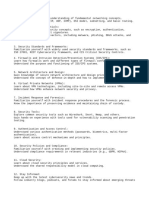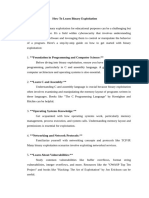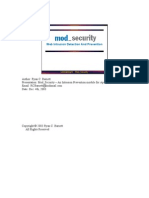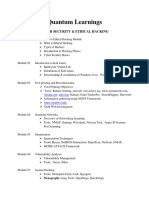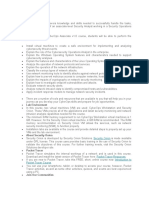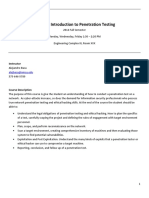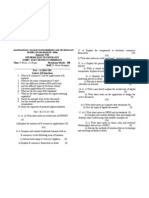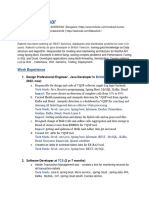Cybersecurity Roadmap1. Introduction to CybersecurityGoal: Provide students with an overview of cybersecurity concepts and the importance of securing digital systems.Topics: Basic definitions, types of security (physical, network, application), importance of cybersecurity, common threats.2. Types of Cyber ThreatsGoal: Understand the most common cyber threats faced today.Topics: Malware, phishing, ransomware, denial-of-service (DoS) attacks, insider threats, socialengineering.Practical: Discuss real-world examples of cyber-attacks.3. Network Introduction & Network ModelGoal: Teach the fundamentals of computer networking.Topics: OSI and TCP/IP models, basic network components (routers, switches, firewalls).Practical: Set up a small network lab using virtual machines.4. IP Addressing and SubnettingGoal: Learn how IP addresses work and the concept of subnetting.Topics: IPv4 and IPv6, classes of IP addresses, subnet masks, CIDR notation.Practical: Subnetting exercises and IP address configuration.5. Network ProtocolsGoal: Understand key network protocols essential for communication and security.Topics: HTTP/S, DNS, TCP/UDP, ICMP, ARP.

Practical: Using Wireshark to analyze network traffic and protocols.---6. Linux Basics & Kali LinuxGoal: Get comfortable with Linux, especially for cybersecurity purposes.Topics: Basic Linux commands, file system structure, user permissions, introduction to KaliLinux (the go-to distro for penetration testing).Practical: Hands-on with Kali Linux for basic tasks and navigation.7. Linux+ (Advanced Linux Skills for Cybersecurity)Goal: Deepen knowledge of Linux for system administration and security.Topics: Shell scripting, managing services, Linux security tools (e.g., iptables, fail2ban), securefile handling.Practical: Advanced tasks like automating security checks with shell scripts.---8. Cyber Defense MechanismsGoal: Learn how to defend networks and systems against threats.Topics: Firewalls, Intrusion Detection Systems (IDS), Intrusion Prevention Systems (IPS),encryption, VPNs, endpoint protection.Practical: Configure firewalls and test IDS/IPS with simulated attacks.---9. Web Exploitation
Goal: Explore the vulnerabilities that exist in web applications.Topics: OWASP Top 10 vulnerabilities (SQL Injection, XSS, CSRF, etc.).Practical: Perform a simple web application penetration test.10. Web Exploitation (Advanced & Practical)Goal: Dive deeper into advanced web exploitation techniques.Topics: Exploiting authentication flaws, advanced injection attacks, bypassing web applicationfirewalls (WAFs).Practical: Exploit an intentionally vulnerable web application (e.g., DVWA, Juice Shop).---11. Binary ExploitationGoal: Introduction to exploiting binary applications.Topics: Buffer overflows, memory corruption, basic fuzzing techniques.Practical: Perform basic binary exploitation exercises in C programs.12. Advanced Binary Exploitation & Mitigation BypassGoal: Advanced binary exploitation techniques and bypassing modern defenses.Topics: Bypassing ASLR, DEP, and other protections, Return-Oriented Programming (ROP).Practical: Exploit a real-world binary with mitigation techniques in place13. Reverse EngineeringGoal: Learn how to reverse engineer software and systems.Topics: Decompilers, disassemblers, understanding assembly code.Practical: Reverse engineer a simple program to understand its functionality.14. Reverse Engineering (Advanced & Practical)
Goal: Master the art of reverse engineering and applying it in real scenarios.Topics: Reverse engineering malware, analyzing packed binaries.Practical: Analyze an advanced malware sample and identify its functions.---15. ForensicsGoal: Learn how to conduct a digital forensic investigation.Topics: Data acquisition, file carving, log analysis, and memory forensics.Practical: Perform a basic forensic investigation using tools like Autopsy and Volatility.16. Forensics (Advanced & Practical)Goal: Advanced forensics techniques applied to real-world cases.Topics: Investigating ransomware, advanced data recovery methods.Practical: Solve a complex forensic challenge using professional-grade tools.---17. Career Paths in CybersecurityGoal: Provide guidance on how to pursue a career in cybersecurity.Topics: Roles like Security Analyst, Penetration Tester, Incident Responder, Forensic Analyst,and more





























